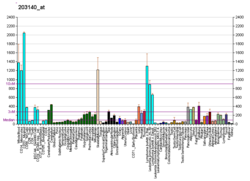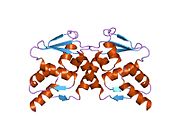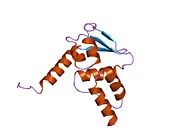Transcription factor for converting Naive T cells to TFH
Bcl-6 (B-cell lymphoma 6) is a protein that in humans is encoded by the BCL6 gene. BCL6 is a master transcription factor for regulation of T follicular helper cells (TFH cells) proliferation. BCL6 has three evolutionary conserved structural domains. The interaction of these domains with corepressors allows for germinal center development and leads to B cell proliferation.
The deletion of BCL6 is known to lead to failure of germinal center formation in the follicles of the lymph nodes, preventing B cells from undergoing somatic hypermutation. Mutations in BCL6 can lead to B cell lymphomas because it promotes unchecked B cell growth. Clinically, BCL6 can be used to diagnose B cell lymphomas and is shown to be upregulated in a number of cancers.
Other BCL genes, including BCL2, BCL3, BCL5, BCL7A, BCL9, and BCL10, also have clinical significance in lymphoma.
Normal physiological function
Structure
The protein encoded by the BCL6 gene is a zinc finger transcription factor that has three evolutionarily conserved domains. BCL6 contains a (1) N-terminal BTB/POZ domain (Broad-complex, Tramtrack and Brick-a-brac/Pox virus and Zin finger family domain), (2) a central RN2 region, and (3) another zinc finger at the C-terminal end. This structure is vital to BCL6’s function – an exon 7 skipping splice variant encodes a shorter form of the protein which lacks the first two zinc fingers of the DNA binding domain, for example.
Function
Bcl-6 is a master transcription factor for the regulation of T follicular helper cells (TFH cells). Bcl-6 is expressed when the cytokines Il-6 and/or Il-21 are recognized; these cytokines can be produced by antigen presenting cells (APCs: B cells, dendritic cells, or macrophages) when activated. This occurs when a naïve T helper cell recognizes antigen and needs to migrate to the follicle as a T follicular helper cell (TFH cell). TFH cells are vital to the generation of germinal centers in the follicles of secondary lymphoid organs, where B cells divide and help fight infections.
As a master transcription factor, BCL6 interacts with a variety of co-repressors and other proteins to influence the T cell lineage. BCL6 has been shown to modulate the STAT-dependent Interleukin 4 (IL-4) responses of B cells and suppress the production of BCL2.
Importantly, Bcl-6 should only be expressed when there is an antigen present and further stimulation of the immune system is necessary, since BCL6 prevents cell death (apoptosis). Unchecked growth can lead to lymphomas. Normally, the action of BCL6 is negatively regulated by the gene PRDM1 encoding the transcription factor Blimp-1. The antagonistic effect with Blimp-1 is a powerful role of BCL6, because it shuts off the normal pathway of differentiation toward other cell types.
Differentiation of TFH Cells
BCL6 is currently considered a lineage-defining transcription factor in TFH cell differentiation. Without the expression of BCL6, naïve CD4+ T helper cells will not turn into TFH cells. When a naïve CD4+ T cell binds to MHC class II and an antigen peptide on a dendritic cell, a signaling cascade ensues in which some proliferating T cells become TFH cells. Signaling through the IL-6 receptor leads to TFH cell differentiation, and in turn the expression of BCL6 in TFH lineage-defined cells. BCL6 allows, through transcriptional regulation, unique cell markers to be expressed, resulting in an effective TFH cell.
Transcriptional regulation of BCL6 is vast and complex, but many of the outcomes of BCL6’s transcriptional regulation on TFH cells have been elucidated. TFH cells upregulate CXCR5, IL-6R, and ICOS during their migration to the germinal center. After interacting with a B cell presenting the cognate antigen in the follicle, they also upregulate SAP, CD200 and BTLA on their cell surface in the newly formed germinal center. Additionally, BCL6 directly binds and suppresses genes that are downregulated in non-TFH cells, including Ccr7, Selplg, and Gpr183, and other chemokine receptor targets.
Clinical Value
Role in B Cell Lymphomas
BCL6 is found to be frequently translocated and hypermutated in diffuse large B cell lymphoma (DLBCL) and contributes to the pathogenesis of DLBCL. BCL6 is exclusively present in the B-cells of both healthy and neoplastic (cancerous) germinal centers. This allows lymphoma’s to be diagnosed based on immunohistochemical staining, revealing the presence of Burkitt's lymphoma, follicular lymphoma and the nodular lymphocyte predominant subtype of Hodgkin's disease. It is often used together with antibodies to Bcl-2 antigen to distinguish neoplastic follicles from those found in benign hyperplasia, for which Bcl-2 is negative.
Many different changes to BCL6 can lead to inhibited activity and are known to be linked with B-cell lymphomas, including direct effects (mutation and post-translational effects) as well as indirect effects (imbalanced interactions with other mutated proteins). Mutations to the transcription factors for BCL6, MEF2B and IRF8, are common in direct transcriptional changes that cause DLBCL. Additionally, post-translational phosphorylation can be affected by mutations in FBXO11. Finally, BCL6’s interaction with other mutated proteins, including CREBBP, EP300, EZH2, and KM2TD, can also lead to B-cell lymphomas. Given its role as a master transcription regulator, many genetic and epigenetic changes can be responsible for B-cell lymphomas; these interacting proteins are likely a few of many that affect BCL6’s function.
Diagnostic Ability
Tracking BLC6 in B cells using immunohistochemical staining or enzyme-linked immunosorbent assay (ELISA) can be used to diagnose cancers and may indicate other illnesses as well. As mentioned previously, tracking BCL6 in tandem with BCL2 can lead to the diagnosis of B-cell lymphomas. More recently, it has been hypothesized that the presence of BCL6 in serum could be used to diagnose endometriosis due to an overactivation of BCL6 in endometriotic females, although this diagnostic method has not been found to work. Nonetheless, the understanding of BCL6 will likely continue to be used to diagnose diseases.
Targeted Therapies
Given BCL6’s role in B-cell lymphomas, it has been suggested as a therapeutic target for cancer treatment. Targeting BCL6 in cancer patients should lead to the deletion of BCL6 in tumor cells. Peptidomimetics, small molecules, and natural compounds have been developed and tested in preclinical models, showing promise of anti-lymphoma activity.
Interactions
BCL6 has been shown to interact with
* BCOR,- BTLA,
- Ccr7,
- CD200,
- C-jun,
- CREBBP,
- CXCR5,
- EP300,
- EZH2,
- Gpr183,
- HDAC1,
- HDAC4,
- HDAC7A,
- HDAC5,
- ICOS,
- IRF8,
- IRF4,
- IL-6R,
- KM2TD,
- MET2B,
- NCOR2
- NCOR2,
- SAP,
- Selplg,
- SMRT,
- ZBTB7A
- T-bet,
- ZBTB16
See also
References
- ^ GRCh38: Ensembl release 89: ENSG00000113916 – Ensembl, May 2017
- ^ GRCm38: Ensembl release 89: ENSMUSG00000022508 – Ensembl, May 2017
- "Human PubMed Reference:". National Center for Biotechnology Information, U.S. National Library of Medicine.
- "Mouse PubMed Reference:". National Center for Biotechnology Information, U.S. National Library of Medicine.
- ^ Owen JA, Punt J, Stranford SA, Jones PP, Kuby J (2013). Kuby immunology. W.H. Freeman. ISBN 978-1-4292-1919-8. OCLC 820117219.
- ^ Yang H, Green MR (2019-11-07). "Epigenetic Programing of B-Cell Lymphoma by BCL6 and Its Genetic Deregulation". Frontiers in Cell and Developmental Biology. 7: 272. doi:10.3389/fcell.2019.00272. PMC 6853842. PMID 31788471.
- Huang X, Shen Y, Liu M, Bi C, Jiang C, Iqbal J, et al. (July 2012). "Quantitative proteomics reveals that miR-155 regulates the PI3K-AKT pathway in diffuse large B-cell lymphoma". The American Journal of Pathology. 181 (1): 26–33. doi:10.1016/j.ajpath.2012.03.013. PMC 3388146. PMID 22609116.
- Nurieva RI, Chung Y, Martinez GJ, Yang XO, Tanaka S, Matskevitch TD, et al. (August 2009). "Bcl6 mediates the development of T follicular helper cells". Science. 325 (5943): 1001–1005. Bibcode:2009Sci...325.1001N. doi:10.1126/science.1176676. PMC 2857334. PMID 19628815.
- Johnston RJ, Poholek AC, DiToro D, Yusuf I, Eto D, Barnett B, et al. (August 2009). "Bcl6 and Blimp-1 are reciprocal and antagonistic regulators of T follicular helper cell differentiation". Science. 325 (5943): 1006–1010. Bibcode:2009Sci...325.1006J. doi:10.1126/science.1175870. PMC 2766560. PMID 19608860.
- ^ Choi J, Crotty S (April 2021). "Bcl6-Mediated Transcriptional Regulation of Follicular Helper T cells (TFH)". Trends in Immunology. 42 (4): 336–349. doi:10.1016/j.it.2021.02.002. PMC 8021443. PMID 33663954.
- Ye BH, Lista F, Lo Coco F, Knowles DM, Offit K, Chaganti RS, et al. (October 1993). "Alterations of a zinc finger-encoding gene, BCL-6, in diffuse large-cell lymphoma". Science. 262 (5134): 747–750. Bibcode:1993Sci...262..747Y. doi:10.1126/science.8235596. PMID 8235596.
- Kerckaert JP, Deweindt C, Tilly H, Quief S, Lecocq G, Bastard C (September 1993). "LAZ3, a novel zinc-finger encoding gene, is disrupted by recurring chromosome 3q27 translocations in human lymphomas". Nature Genetics. 5 (1): 66–70. doi:10.1038/ng0993-66. PMID 8220427. S2CID 12575122.
- Migliazza A, Martinotti S, Chen W, Fusco C, Ye BH, Knowles DM, et al. (December 1995). "Frequent somatic hypermutation of the 5' noncoding region of the BCL6 gene in B-cell lymphoma". Proceedings of the National Academy of Sciences of the United States of America. 92 (26): 12520–12524. Bibcode:1995PNAS...9212520M. doi:10.1073/pnas.92.26.12520. PMC 40389. PMID 8618933.
- Chetty R, Cooper K, Gown AM (2016). Leong's manual of diagnostic antibodies for immunohistology (3rd ed.). Cambridge: Cambridge university press. ISBN 978-1-107-07778-2.
- Yoo JY, Kim TH, Fazleabas AT, Palomino WA, Ahn SH, Tayade C, et al. (July 2017). "KRAS Activation and over-expression of SIRT1/BCL6 Contributes to the Pathogenesis of Endometriosis and Progesterone Resistance". Scientific Reports. 7 (1): 6765. Bibcode:2017NatSR...7.6765Y. doi:10.1038/s41598-017-04577-w. PMC 5533722. PMID 28754906.
- Evans-Hoeker E, Lessey BA, Jeong JW, Savaris RF, Palomino WA, Yuan L, et al. (September 2016). "Endometrial BCL6 Overexpression in Eutopic Endometrium of Women With Endometriosis". Reproductive Sciences. 23 (9): 1234–1241. doi:10.1177/1933719116649711. PMC 5933165. PMID 27222232.
- Sansone AM, Hisrich BV, Young RB, Abel WF, Bowens Z, Blair BB, et al. (September 2021). "Evaluation of BCL6 and SIRT1 as Non-Invasive Diagnostic Markers of Endometriosis". Current Issues in Molecular Biology. 43 (3): 1350–1360. doi:10.3390/cimb43030096. PMC 8929102. PMID 34698105.
- Leeman-Neill RJ, Bhagat G (February 2018). "BCL6 as a therapeutic target for lymphoma". Expert Opinion on Therapeutic Targets. 22 (2): 143–152. doi:10.1080/14728222.2018.1420782. PMID 29262721. S2CID 22638255.
- ^ Huynh KD, Fischle W, Verdin E, Bardwell VJ (July 2000). "BCoR, a novel corepressor involved in BCL-6 repression". Genes & Development. 14 (14): 1810–1823. doi:10.1101/gad.14.14.1810. PMC 316791. PMID 10898795.
- Vasanwala FH, Kusam S, Toney LM, Dent AL (August 2002). "Repression of AP-1 function: a mechanism for the regulation of Blimp-1 expression and B lymphocyte differentiation by the B cell lymphoma-6 protooncogene". Journal of Immunology. 169 (4): 1922–1929. doi:10.4049/jimmunol.169.4.1922. PMID 12165517.
- ^ David G, Alland L, Hong SH, Wong CW, DePinho RA, Dejean A (May 1998). "Histone deacetylase associated with mSin3A mediates repression by the acute promyelocytic leukemia-associated PLZF protein". Oncogene. 16 (19): 2549–2556. doi:10.1038/sj.onc.1202043. PMID 9627120.
- ^ Deltour S, Guerardel C, Leprince D (December 1999). "Recruitment of SMRT/N-CoR-mSin3A-HDAC-repressing complexes is not a general mechanism for BTB/POZ transcriptional repressors: the case of HIC-1 and gammaFBP-B". Proceedings of the National Academy of Sciences of the United States of America. 96 (26): 14831–14836. Bibcode:1999PNAS...9614831D. doi:10.1073/pnas.96.26.14831. PMC 24733. PMID 10611298.
- ^ Lemercier C, Brocard MP, Puvion-Dutilleul F, Kao HY, Albagli O, Khochbin S (June 2002). "Class II histone deacetylases are directly recruited by BCL6 transcriptional repressor". The Journal of Biological Chemistry. 277 (24): 22045–22052. doi:10.1074/jbc.M201736200. PMID 11929873.
- Gupta S, Jiang M, Anthony A, Pernis AB (December 1999). "Lineage-specific modulation of interleukin 4 signaling by interferon regulatory factor 4". The Journal of Experimental Medicine. 190 (12): 1837–1848. doi:10.1084/jem.190.12.1837. PMC 2195723. PMID 10601358.
- ^ Wong CW, Privalsky ML (October 1998). "Components of the SMRT corepressor complex exhibit distinctive interactions with the POZ domain oncoproteins PLZF, PLZF-RARalpha, and BCL-6". The Journal of Biological Chemistry. 273 (42): 27695–27702. doi:10.1074/jbc.273.42.27695. PMID 9765306.
- Davies JM, Hawe N, Kabarowski J, Huang QH, Zhu J, Brand NJ, et al. (January 1999). "Novel BTB/POZ domain zinc-finger protein, LRF, is a potential target of the LAZ-3/BCL-6 oncogene". Oncogene. 18 (2): 365–375. doi:10.1038/sj.onc.1202332. PMID 9927193.
- Oestreich KJ, Huang AC, Weinmann AS (May 2011). "The lineage-defining factors T-bet and Bcl-6 collaborate to regulate Th1 gene expression patterns". The Journal of Experimental Medicine. 208 (5): 1001–1013. doi:10.1084/jem.20102144. PMC 3092354. PMID 21518797.
- Dhordain P, Albagli O, Honore N, Guidez F, Lantoine D, Schmid M, et al. (December 2000). "Colocalization and heteromerization between the two human oncogene POZ/zinc finger proteins, LAZ3 (BCL6) and PLZF". Oncogene. 19 (54): 6240–6250. doi:10.1038/sj.onc.1203976. PMID 11175338.
Further reading
- Ueda C, Akasaka T, Ohno H (July 2002). "Non-immunoglobulin/BCL6 gene fusion in diffuse large B-cell lymphoma: prognostic implications". Leukemia & Lymphoma. 43 (7): 1375–1381. doi:10.1080/10428190290033305. PMID 12389616. S2CID 27096971.
- Niu H (December 2002). "The proto-oncogene BCL-6 in normal and malignant B cell development". Hematological Oncology. 20 (4): 155–166. doi:10.1002/hon.689. PMID 12469325. S2CID 24245607.
- Tokuhisa T (December 2002). "". Tanpakushitsu Kakusan Koso. Protein, Nucleic Acid, Enzyme. 47 (16 Suppl): 2306–2312. PMID 12518453.
- Ohno H (April 2004). "Pathogenetic role of BCL6 translocation in B-cell non-Hodgkin's lymphoma". Histology and Histopathology. 19 (2): 637–650. doi:10.14670/HH-19.637. PMID 15024721.
- Pasqualucci L, Bereshchenko O, Niu H, Klein U, Basso K, Guglielmino R, et al. (2004). "Molecular pathogenesis of non-Hodgkin's lymphoma: the role of Bcl-6". Leukemia & Lymphoma. 44 (Suppl 3): S5-12. doi:10.1080/10428190310001621588. PMID 15202519. S2CID 25565667.
- Jardin F, Ruminy P, Bastard C, Tilly H (February 2007). "The BCL6 proto-oncogene: a leading role during germinal center development and lymphomagenesis". Pathologie-Biologie. 55 (1): 73–83. doi:10.1016/j.patbio.2006.04.001. PMID 16815642.
External links
- BCL6+protein,+human at the U.S. National Library of Medicine Medical Subject Headings (MeSH)
- Human BCL6 genome location and BCL6 gene details page in the UCSC Genome Browser.
| PDB gallery | |
|---|---|
| Transcription factors and intracellular receptors | |||||||||||||||||||||||||||||||
|---|---|---|---|---|---|---|---|---|---|---|---|---|---|---|---|---|---|---|---|---|---|---|---|---|---|---|---|---|---|---|---|
| |||||||||||||||||||||||||||||||
| |||||||||||||||||||||||||||||||
| |||||||||||||||||||||||||||||||
| |||||||||||||||||||||||||||||||
| |||||||||||||||||||||||||||||||
| see also transcription factor/coregulator deficiencies | |||||||||||||||||||||||||||||||
This article incorporates text from the United States National Library of Medicine, which is in the public domain.
Categories:








